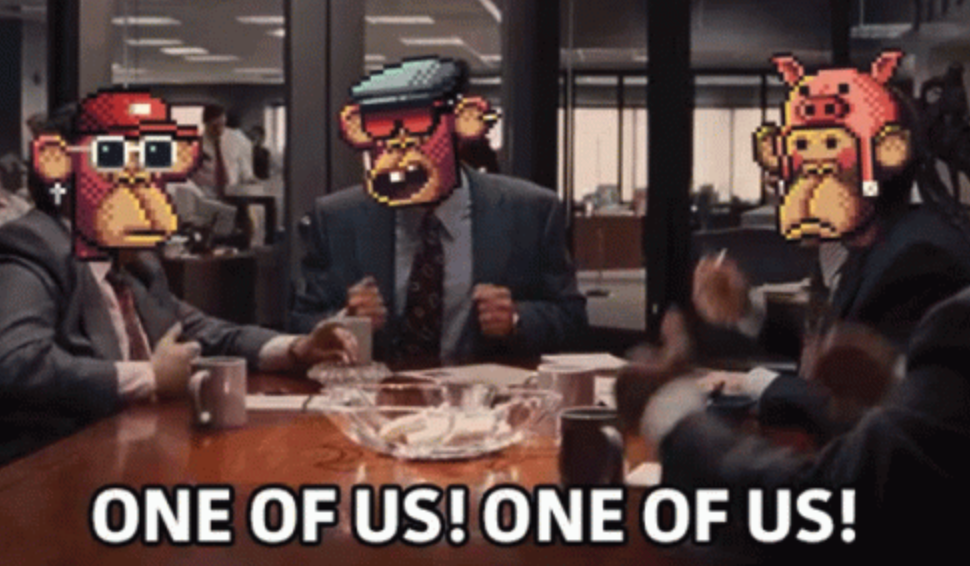Onboarding new people to web3 depends on the story we tell.
“The most powerful person in the world is the storyteller.” — Steve Jobs.
“You can have the laws. Give me the stories and I’ll change the world.” — attributed to Aristotle.
These quotes aren’t talking about writing the next great novel. They are talking about disrupting the tech industry or a nation or a culture. So, what role does story (and storytelling) play in a fast-paced modern world where unprecedented data and information are available on our phones? What about the frontier of blockchain technology and web3 that feels like the American Western frontier or settling a new world?
“The most powerful person in the world is the storyteller.”
STEVE JOBS
The answer, as in all great movements that disrupt the status quo is:
Whoever tells the best story wins.
People are wired for stories. There is something in us that resonates with story as a form of communication. A different part of our brain lights up on scans when hearing a story. Our body releases the “love hormone” when we are gripped by a story.
Everyone loves a story. Everyone lives a story. Everyone tells a story.
What story are we telling?

In film and fiction writing there is a well-known idea that all stories follow a universal pattern. It’s called the Hero’s Journey. Joseph Campbell wrote about it in “The Hero With A Thousand Faces.”
George Lucas depicted the Hero’s Journey onscreen when he created “Star Wars.”
In its simplest form, a story can be defined as: a character wants something and has to overcome a challenge to get it. But in a more advanced form, the Hero’s Journey demonstrates that the most popular stories in history follow a pattern and form.
The Hero’s Journey goes like this:
A character (the hero) lives in an ordinary world and receives a call to adventure to “save the village.” They are reluctant and refuse the call. But they meet a mentor or guide who convinces them to take the call and escorts them across a threshold into a new world. The hero meets and gathers a group of friends and allies, faces enemies, and is tested on many fronts. As the journey marches forward in the face of these challenges, they come to what appears to be an insurmountable challenge. As they take on this challenge, they face near-certain death. But they come out alive, reborn as it were. They get the thing that will save the village, and continue on their journey where they face one last encounter with death. They survive, accomplish the mission, and are celebrated by the village.
You can try it with popular stories like— “Star Wars,” “The Wizard of Oz,” “Lord of the Rings,” and “Hunger Games.” You can chart it through less likely stories such as “Tommy Boy” or “Finding Nemo.”
For the visual learners, here is the Hero’s Journey:

This is how stories work because this is how we work.
So, what does this have to do with web3?
If every person and every project and every community is telling a story, what story are we telling in web3? Are we following this proven path that resonates with people in our efforts to engage people to cross the threshold and enter this new web3 world?
And how are we doing in our pursuit of telling the best story so that we might win?
I’m going to suggest: not so well.
Let’s take a look and break things down…

You Are Not the Hero
Every scroll of a timeline is filled with hero after hero after hero after…
“Project X just flipped project Y.”
“Project A has the best art.”
“This or that community raids the hardest.”
“1 ETH for project Z is FUD.”
Should I continue? (Please note: This isn’t a knock on these kinds of posts, but only an evaluation of how they contribute to the story you are telling).
Or maybe the more subtle…
“Found my grail.”
[Insert your favorite project call line here]
[Insert favorite insider emoji or icon here]
[Insert favorite project meme here—maybe with requisite head swaps of project art]


Now, let’s be clear: sharing your love for a project or community makes complete sense and has a fun and appropriate place in the web3 world. Just stick with me for a minute as we continue the discussion.
When we talk about onboarding new people, we need to understand that we are not the hero of the story. Right now, a scroll through web3/NFT Twitter looks like a UEFA Champions League or NFL Football group chat. Allegiances pitted against one another for on-field and off-field dominance. That can be a lot of fun and provide insiders countless hours of (mostly) good-natured enjoyment. But think about what it’s like to enter that world if you are on the outside and don’t know anything about the sport. First, you don’t know the lingo, the teams, and the traditions, and it feels like everybody is a part of the fun but you. But even more important than that, everyone is already so confident that their team is the best. There’s no convincing anyone of anything. Everything is already settled. If a new person enters the chat and they are a fan of your team(s), you welcome them warmly. If there are not, you move on and go back to loudly proclaiming your superior position among the group.
This point alone is creating a significant problem for onboarding new people.
Let’s talk about the solution…

You and Your Project Are the Guide or Mentor
Using the Hero’s Journey, we need to understand that the power character is the guide or mentor. The hero is a flawed, reluctant character. The guide has the “magic,” the wisdom, and the confidence to get the hero through the journey. Obi-Wan, Gandalf, and Haymitch are the power characters.
And so, as a project, a team, and active members of a community you need people who take a look into this new world to see a guide and a mentor for them as they seek to live out their own hero’s journey.
Now, there is plenty of room for fun and memes, for celebration and for championing of what you love, but it can’t be the only story. It can’t even be the main story—not if you want to reach people and expand the horizons of your project and web3 or NFTs in general.
The thread that needs to run through the story you are telling is that you are Obi-Wan for the Luke Skywalkers you want to onboard.
This is not what we are doing at present in web3. It’s not that nobody hits this note from time to time (more on that later). But the heartbeat of nearly every story that is being told month over month, is bludgeoning followers with heroes battling heroes.
And here is the problem with that: When a hero meets another hero, at best he takes a look, nods his head, and moves on because he inherently knows he’s looking for a mentor and another hero doesn’t help him. At worst, he sees a competitor or enemy trying to take what is his. Either way, the hero will move on in search of a mentor or guide that can help him on his journey. You need to position yourself as Obi-Wan so the hero recognizes you and doesn’t move on.

Your Community Is the Band of Friends and Allies
No hero goes on a quest alone. Every journey includes finding a team, a band of helpers for the journey. Luke had Chewbacca, Leia, and Han Solo. Dorothy had the Tin Man, the Scarecrow, the Lion, and Toto. Katniss had Peeta, Wiress, Beetee, and Mags.
So, if you position yourself as the mentor and guide, you can encourage and help your committed community to be the friends and allies that come alongside the hero to journey together on the quest. Sure, they can still have fun, post memes, champion and celebrate the things they love about the project. But there needs to be a clear thread through your story when the outsider comes in that says, “We are here to help you succeed on your journey.”
Imagine how that might change a copy and pasta raid—I’m not sure that copy and pasta is the best form of telling your story, but for the mental exercise you get the point!

The Audience You Want to Onboard Is the Hero
If you are following closely and tracking with me, then you already know this point. But it’s important to discuss it explicitly here.
The outsider is the hero. The ‘not yet’ member of your community is the hero. Think about that and its implications.
If you take nothing else from this article, remember this: You or your project are not the hero. The outsider who you want in your project is the hero.
“If you take nothing else from this article, remember this: You or your project are not the hero. The outsider who you want in your project is the hero.”
BRADQ
Now, let’s understand that in the web3 world, you have two audiences that are prospective heroes looking for their guide or mentor. There are insiders who are native to web3 and NFTs—members of other projects and communities that aren’t yet a part of yours. And there are the outsiders—the web3 curious or the web2 normies who will explore and eventually settle in the new world.
Each of those audiences requires different things from the mentor and from the friends and allies. In some ways the story we most predominantly tell currently is constructed to grab the attention of the insider—the web3 native who hasn’t yet joined our community. But even for them, the current story is not the best and most productive way to win them over. And for the outsider, they will just see a bunch of heroes, move on, and find their mentor somewhere else.
Now it’s worth pausing here and noting that there are founders and communities that are closer to where we want to be with our storytelling than most others. One that sticks out to me is The Zen Academy. It was founded by Zeneca, who I don’t know personally, but really appreciate his approach to web3. The Zen Academy is an educational community onboarding people into web3. Zeneca, along with his team, have a strong sense of being the guide or mentor. I don’t know if it’s an explicit strategy or by nature of their chosen project of educating and onboarding which lends toward the guide role.
There are two lesser-known communities that also do a good job of performing the role of ‘friends and allies’ to new people. It’s clear that the founders create a contagious culture to be helpful, positive, and encouraging communities. These are The Antz and Camels and both are plentiful with people who are intentionally helpful, kind, and encouraging.
While these and others hit the right note in certain areas, all communities and projects can more effectively apply the strategy we are discussing regardless of how well or how poorly they may be doing with certain parts of the story.
It’s probably also worth noting that there are several popular and successful projects that speak explicitly about storytelling. I have found that is mostly a reference to building a storytelling world for their NFTs and IP, not so much a reference to how they tell their story. Most, if not all of these, position themselves as the hero of the story.

There are numerous projects, communities, and individuals who are thriving in these early days in the new world who may not be following the strategy I am laying out here. My argument is not that everybody is failing because they aren’t telling their story right. It’s also not that everybody who follows this strategy will succeed. My interest is not so much where we are right now in defining “success.” My eyes are not on the shuffling of a few hundred, a few thousand, or even ten thousand people in and out of different communities and projects. I’m looking out on the horizon when the web3 world isn’t only digital art, gaming, or other ‘club memberships,’ as some refer to the current moment. I’m looking to when web3 is likely not called by such a term, the term NFT may not even be used, and people won’t talk about the blockchain. I’m looking to when you won’t attend a concert or visit a restaurant without a wallet on your phone that determines where you sit and what swag you get. I’m looking to when real estate transactions, health records, and untold ideas we can’t even think of yet are a part of web3.
That time is coming quicker than we think. In the months and years to come, I believe it will be the projects and people who tell the best story who will win—the story that naturally resonates with the people in the old world to encourage them to “cross the threshold” and settle in the new world. Those are the projects that will “save the village” and be celebrated.
Editor’s note: bradq consults with businesses and organizations to help them tell their stories better, build audiences, and gain loyalty. He settled into the new world of web3 in early 2022, just missing the bull run. Since then, he has been working mostly behind the scenes to encourage and to help web3 builders communicate more effectively and think more deeply about their strategies in building a loyal audience.
The post Op-Ed: We Need to Tell Better Web3 Stories — Here’s How appeared first on nft now.







Leave a Reply